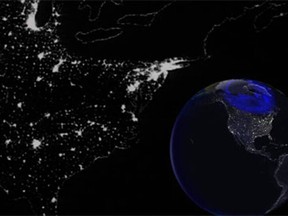They don’t seem to be harmful to folks on Earth, however they’ll play havoc with electrical grids. Simply ask Hydro-Quebec

Article content material
This week it was reported {that a} photo voltaic storm had struck the Earth a day forward of schedule, for unknown causes. Some speculated that the coronal mass ejection (CME) that was the reason for the storm was transferring sooner than anticipated. Others steered it was a wholly totally different CME that had escaped our discover. Right here’s what to learn about photo voltaic storms.
Commercial 2
Article content material
What’s a photo voltaic storm?
Article content material
A photo voltaic storm is a disturbance on the floor of the solar, often within the kind of a big explosion known as a photo voltaic flare, or a burst of plasma often called a coronal mass ejection, or CME. When the charged particles from the storm attain the Earth they intervene with our planet’s magnetic subject in what’s often called a geomagnetic storm.
Are they harmful?
Photo voltaic storms pose no direct danger to people, so long as they’re shielded by the Earth’s environment. So in the event you’re not in area, you’re high quality. In reality, they make for excellent viewing of the Northern Lights, because the Earth’s auroral shows turn into brighter and are seen farther south than typical.
Nevertheless, they’ll pose nice dangers to electrical and digital gear. On March 13, 1989, Hydro-Quebec skilled an entire blackout of its system as a consequence of a strong photo voltaic storm. The photo voltaic particles couldn’t simply move by means of the Canadian Defend and as a substitute discovered an outlet by means of transmission traces. The province subsequently invested billions of {dollars} in toughening up its techniques towards future storms.
Commercial 3
Article content material
Much more highly effective was the Carrington Occasion, a photo voltaic storm that hit the Earth in 1859 and stays the strongest one recorded up to now. Telegraph operators reported sparking and even small fires of their gear, whereas some disconnected their energy sources and have been nonetheless in a position to obtain and transmit messages simply through the use of the present passing by means of the environment.
A photo voltaic storm in February of 2022 precipitated 40 SpaceX Starlink satellites to fail and fall again to Earth throughout launch, not as a result of their electronics have been fried, however as a result of the storm precipitated Earth’s outer environment to warmth up and develop barely, which means the small satellites didn’t have sufficient gasoline to achieve orbit.
That mentioned, it must be famous that photo voltaic storms are likely to have an effect on large-scale infrastructure resembling energy traces, and never particular person units like a cellphone, laptop or automobile. In a current interview with Scientific American, heliophysicist Erika Palmerio suggested warning, not panic.
Commercial 4
Article content material
“As an individual who works with this each day, I’m far more fearful of a ‘doomsday’ derived from terrestrial climate like forest fires, hurricanes and excessive climate,” she mentioned. “We’ve got to observe, and we’ve to be ready. However we shouldn’t have to lose sleep over this.”

Can we predict photo voltaic storms?
Very similar to terrestrial climate, photo voltaic storms are unpredictable. However, just like the climate, we will make forecasts and educated guesses. Photo voltaic flares and storms have a tendency to achieve their peak roughly each 11 years, because the solar goes by means of what’s often called a photo voltaic cycle. Photo voltaic cycle 1 began in 1755. We’re close to the height of photo voltaic cycle 25 now, anticipated to achieve its most someday between now and 2025. So the following few years are more likely to see extra and stronger photo voltaic storms.
Commercial 5
Article content material
It’s additionally price noting that photo voltaic flares launch power on the pace of sunshine, so there’s no advance warning for the eight minutes it takes their power to achieve us from the solar. Coronal mass ejections can take a number of days to achieve Earth, so some warning is obtainable.
Spacecraft just like the Photo voltaic Terrestrial Relations Observatory (launched in 2006) and the Parker Photo voltaic Probe (launched in 2018) are finding out the solar and its corona to assist scientists higher perceive their behaviour.
We’re additionally getting help from different planets. Presently, Mars is on the other aspect of the solar from the Earth, and so scientists have requested the Perseverance rover there to periodically take a peek on the solar and report again on any sunspot exercise not seen from Earth. The Curiosity rover carried out the same job in 2015, close to the earlier photo voltaic most, though its cameras weren’t as delicate.
-

The solar was ‘smiling’ in a NASA photograph. It could be a warning
-

Photo voltaic Orbiter mission shares closest ever photos of the solar
Feedback
Postmedia is dedicated to sustaining a energetic however civil discussion board for dialogue and encourage all readers to share their views on our articles. Feedback might take as much as an hour for moderation earlier than showing on the positioning. We ask you to maintain your feedback related and respectful. We’ve got enabled e-mail notifications—you’ll now obtain an e-mail in the event you obtain a reply to your remark, there’s an replace to a remark thread you comply with or if a consumer you comply with feedback. Go to our Neighborhood Pointers for extra info and particulars on how you can alter your e-mail settings.
Be part of the Dialog